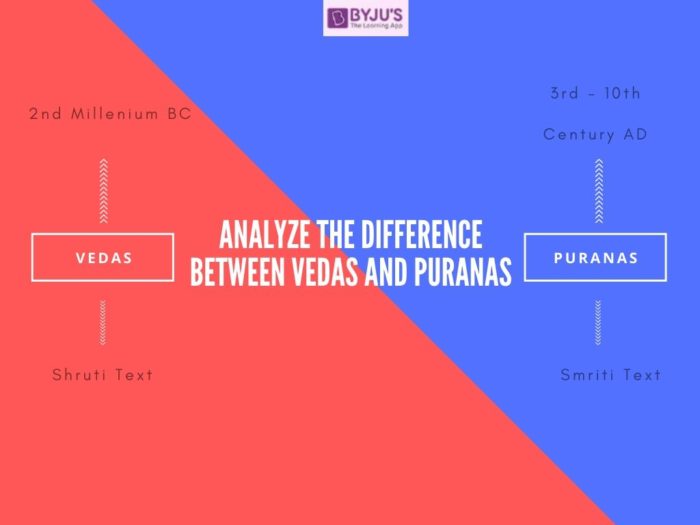Vedas and Puranas are important texts that define Indian culture at its finest. Yet there are certain fundamental differences between them.
The Vedas are a large body of religious texts composed in Vedic Sanskrit and are widely regarded as the oldest scriptures of Hinduism.
The Puranas are a vast collection of Indian literature that cover a wide range of topics, such as legends and traditional folklore.
Aspirants can find more Difference Between Articles, by visiting the linked page.

This article will further highlight the differences between Vedas and Puranas within the context of the IAS Exam.
Differences between Vedas and Puranas
| Vedas |
Puranas |
There are four types of Vedas:
|
There is 1 Maha Purana, 17 Mukhya Purana (Major Puranas), 18 Upa Puranas (Minor Puranas) with over 400,00 verses |
Each Veda has four subdivisions. They consist of the following:
|
The literature of the Puranas is vast and converse a diversified range of topics that include but are not limited to:
|
| Vedas are considered as Shruti, which distinguishes them from other scriptures. Shruti means “that which is heard” in Sanskrit and is used to describe the most authoritative and religious texts in Hinduism | The Puranas are considered Smriti texts (meaning “that which is remembered). Smriti texts do not have the authority of Shruti scriptures, but they are still held in equal regard |
| The Vedas were orally transmitted since the 2nd Millenium BC. The Rig Veda was composed in its written form around 1500 BC – 1200 BC. The Sama, Yajur and Atharva Vedas were composed around 1200 BC – 900 BC. | The first versions of the Puranas were likely to be composed between the 3rd and 10th Century CE. |
| Traditionally, Veda Vyasa is regarded as the compiler of the Vedas. | The 18 Upa Puranas had their origins in the work of Lomaharshana (a disciple of Ved Vyasa) and his three students – the Mulasamhita. |
Both Vedas and Puranas are topics covered under the Indian History segment of the UPSC IAS Exam. Aspirants can refer to the below links to study this segment:
- NCERT Ancient Indian History Notes for UPSC
- NCERT Medieval Indian History Notes for UPSC
- NCERT Modern Indian History Notes for UPSC
- Difference Between the Early Vedic Period and Later Vedic Period
- Difference Between Vedas and Upanishads
- Vedic Literature for UPSC
Difference Between Vedas and Puranas – Download PDF Here
FAQ about Vedas and Puranas
What are the subjects dealt with in Puranas?
What are the four main Vedas?
Become familiar with the general pattern of the IAS Exam by visiting the IAS Syllabus page. For more exam-related preparation materials, refer to the links given in the table below:
Related Links
| NCERT Books Free Download | UPSC Exam Pattern | NCERT Notes for UPSC 2023 |
| Intangible Cultural Heritage | Indian Personalities | PIB Summary and Analysis |
| Biological Weathering | Safety Valve Theory | WPI Index |
Comments